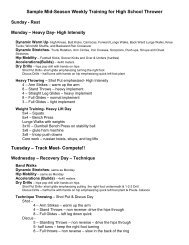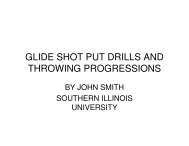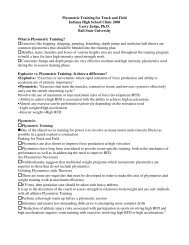Considerations for the High Jump - iatccc
Considerations for the High Jump - iatccc
Considerations for the High Jump - iatccc
You also want an ePaper? Increase the reach of your titles
YUMPU automatically turns print PDFs into web optimized ePapers that Google loves.
<strong>Considerations</strong> <strong>for</strong> <strong>the</strong> <strong>High</strong><br />
<strong>Jump</strong><br />
Mike Erb<br />
Assistant Women’s Track and Field Coach<br />
University of Illinois<br />
Overview<br />
Commonalities<br />
<strong>Considerations</strong> <strong>for</strong> <strong>the</strong> Approach<br />
Training Inventory<br />
Program Design<br />
Commonalities<br />
Acceleration<br />
Body Angle/Shin Angle<br />
Complete Extension of Joints<br />
Arm Action<br />
Commonalities<br />
Posture<br />
Ankle/Hip/Shoulder Alignment<br />
Summation of Forces<br />
Acceleration thru Takeoff<br />
Commonalities<br />
Ankle Dorsiflexion
Pre-Tension in Foot<br />
Toes Up<br />
Commonalities<br />
Sprint Mechanics<br />
Vertical Pushing<br />
Combination of Posture/Acceleration/Dorsiflexion<br />
Maintenance while Curve Running<br />
Commonalities<br />
Takeoff Mechanics<br />
Penultimate Step<br />
Rhythm to <strong>Jump</strong><br />
Foot Contact at Takeoff<br />
Approach <strong>Considerations</strong><br />
Starting Point Dependant on Several Factors<br />
Strength of Athlete<br />
Speed of Athlete<br />
Experience of Athlete<br />
Do not allow athlete to have more approach than <strong>the</strong>y can<br />
handle<br />
Approach <strong>Considerations</strong><br />
Linear to Curve<br />
Regardless of length of approach, both linear and curved<br />
running must be present<br />
Generally speaking, <strong>the</strong> number of linear and curved steps will<br />
be close to equal
Maintain straight <strong>for</strong>ward visual focus during linear portion of<br />
approach<br />
Approach <strong>Considerations</strong><br />
Transition<br />
Initiated by pressure on outside foot<br />
Anticipate curve initiation<br />
Body must transition as a whole<br />
Slight turn in outside foot<br />
Approach <strong>Considerations</strong><br />
Curve Running<br />
Maintain total body lean<br />
Long axis of foot must remain on curve at all times<br />
Entire body must remain perpendicular to curve<br />
Vertical pushing must remain, although at angle<br />
Outer arm begins deviating from mid-line<br />
Approach <strong>Considerations</strong><br />
Takeoff<br />
Visual Focus on left standard<br />
Lowering of Center of Mass<br />
Heel Lead, Flat Foot Contact<br />
Takeoff occurs just inside right standard, distance from bar<br />
determined by athlete’s ability<br />
Double Arm vs. Single Arm<br />
Over <strong>the</strong> Bar<br />
Rotation will occur only if approach and takeoff are<br />
properly executed<br />
Lead leg drives and drops to allow movement in hips<br />
Allow shoulders to follow parabolic curve<br />
Chin to chest <strong>for</strong> leg clearance<br />
Training Inventory<br />
Many roads to Rome<br />
How more important than what<br />
Identify necessary components
Plyometrics/Stretch Shortening Cycle<br />
Sprint Mechanics<br />
CNS Demands<br />
Training Inventory<br />
Exercises<br />
Circle Running<br />
Serpentine Running<br />
Short Approach <strong>Jump</strong>ing – work from <strong>the</strong> bar backwards<br />
Full Approach Rehearsal<br />
Training Design<br />
Complimentary vs. Compatibility<br />
Key to training design is understanding demands placed on <strong>the</strong> body<br />
Complementary training requires different demands, allowing one system to<br />
recover<br />
Example: high demand plyometrics followed by general strength work<br />
Compatible training places similar demands on body and its systems and<br />
should be used toge<strong>the</strong>r<br />
Example: high demand plyometrics and olympic lifts<br />
Training Design<br />
Every Day is <strong>High</strong> <strong>Jump</strong> Practice!!<br />
Regardless of <strong>the</strong> exercises per<strong>for</strong>med, be sure to know <strong>the</strong><br />
“why” of what is done<br />
Never sacrifice quality <strong>for</strong> quantity<br />
Look <strong>for</strong> teachable moments from warm up to cool down<br />
Have Fun!!!!!
















